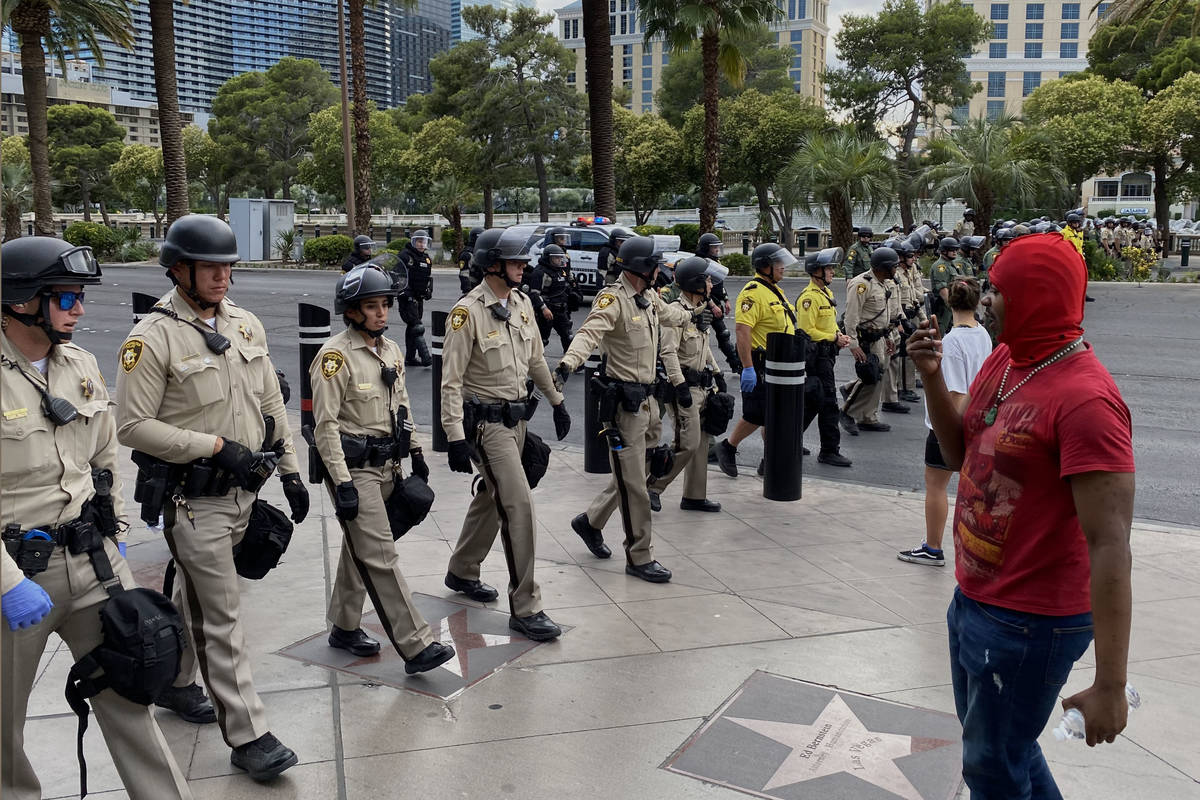Las Vegas police issue release to clarify handling of protests
The Metropolitan Police Department on Friday afternoon said it was reviewing its policy regarding officers’ response to protests and released information intended to “provide guidance” regarding future demonstrations over police brutality and racism.
The Friday news release came a day after a group of legal observers and their attorneys held a press conference and disputed allegations from Clark County Sheriff Joe Lombardo that the observers provoked their own arrests during a weekend protest on the Strip. At numerous demonstrations since late May, which were spurred by the death of George Floyd in Minneapolis police custody, dozens of people have been detained or arrested, including protesters, two journalists and the legal observers.
“The Las Vegas Metropolitan Police Department hears the voice of our community and we are committed to working with all stake holders to implement meaningful reform, build trust, and improve as a police agency,” the department said in the statement.
Lisa Rasmussen, a lawyer for three of the legal observers who were detained, said she hoped Metro’s statement means that future protests will be less contentious.
“I hope that going forward, things will not be as aggravated as they have been previously with regards to Metro’s treatment of the protests and the legal observers,” said Rasmussen, who also addressed the media during Thursday’s press conference.
Metro said police have spoken with groups including the American Civil Liberties Union of Nevada, Black Lives Matter, the National Lawyers Guild, the Progressive Leadership Alliance of Nevada, the Clark County Public Defender’s Office, the Clark County Board of Commissioners, the Attorney General’s Office and the Las Vegas City Council.
During the meetings, “questions have been asked regarding (Metro’s) role and response to protests,” the department said, later adding in the statement that documents released Friday were meant to answer those questions and “provide guidance on how we can ensure our community can continue to exercise its First Amendment Rights in a safe and effective manner.”
Metro said that during future protests, police will “attempt to communicate with legal observers” to establish a “designated liaison.” If the liaison requests information, police will tell that person about arrests and police action “when possible to reduce potential conflict.”
The department also said if dispersal orders are given at protests, police will “attempt to give the dispersal order from multiple directions” so it’s easier for protesters to hear. Metro also vowed that officers will give a “clear path” for protesters to leave “to avoid confusion and conflict.”
The announcements appear to address concerns brought up during a press conference Thursday regarding at least seven attorneys and law students who were detained Saturday. Those detained were trained by the National Lawyers Guild to monitor and document interactions with police and demonstrators.
At Thursday’s press conference, Deputy Public Defender John Piro, who was among those arrested, described being “boxed in” by police during the protest, which he said left protesters confused about where to go when told to disperse.
“There is no video of my clients agitating,” Rasmussen said Thursday. “There’s no video of my clients breaking the law. There’s no video of my clients obstructing traffic on a street. … What I think is clear from the video that we’ve shown you is that Metro has continued to have an outsized response to peaceful protests on the Las Vegas Strip.”
In Metro’s statement Friday, the department asserted that “all persons in the immediate area must leave” during a dispersal order, and anyone who fails to do so could be arrested. That includes someone who is “a peaceful protester not involved in the illegal activity.”
The department appeared to be citing Nevada Revised Statue 203.020, which states that people may be guilty of a misdemeanor if they “assemble for the purpose of disturbing the public peace, or committing any unlawful act, and do not disperse” when commanded to do so by a public official.
Rasmussen on Friday said the law’s language is “vague,” but that “it appears that Metro has a better understanding of the role of legal observers, from the press release that I saw, and I’m very happy about that.”
Earlier this week, Lombardo said the legal observers were “antagonizing and obstructing officers” before police arrested them. The legal observers were detained, some for several hours, including one who was booked into the Clark County Detention Center, and were issued citations for a misdemeanor charge of failing to walk on a sidewalk where provided.
Metro on Friday said dispersal orders are given when “illegal activity is occurring at the protest.” The department said uniformed officers will give the orders at 10-minute intervals in English and Spanish, and it may be repeated up to three times, “depending on the severity of the illegal activity that is occurring.”
The department listed examples of illegal activity, including property damage, “harming other protesters or bystanders,” throwing rocks or “bottles,” and “intentionally obstructing the roadways.”
Metro said that “traffic laws are still applicable during a protest,” and that people should walk on sidewalks and not in the road, not block private driveways, obey “traffic control devices,” and not walk in front of traffic or “impede traffic.”
The department’s statement on Friday did not say when officers would fire tear gas or less-than-lethal rounds toward protesters.
Since police across the U.S. have used tear gas against protesters, some officials have called for officers to stop using the chemical weapons. The city of Columbus, Ohio, and federal judges in Seattle, Washington, and Portland, Oregon have ordered the respective city police departments to stop using tear gas.
Metro also listed items that would be considered weapons and would be “prohibited” from protests, although the department did not say what would happen if someone had an item on the list.
The items listed by the department are:
— Sticks
— Wood or lumber larger than 1/2-inch thick and 2-inches wide
— Metal or plastic pipes, unless it is less than 1/2-inch thick and hollow, and is being used to support a banner or flag
— Baseball bats that aren’t made of foam, paper or plastic
— More than 0.5 ounces of aerosol spray, mace or pepper spray
— Chains
— Bricks, rocks, glass bottles, pieces of asphalt or concrete
— Shields made of metal, wood or hard plastic
— Projectile launchers, wrist rockets, slingshots or catapults
— Box cutters, ice picks, axes and knives with a blade larger than 3 inches
— Tasers, stun guns and pellet guns
— Bottles filled with any flammable, biohazard or noxious matter “with intent to throw or disperse,” as well as flame torches or lanterns, excluding candles
Contact Katelyn Newberg at knewberg@reviewjournal.com or 702-383-0240. Follow @k_newberg on Twitter.























